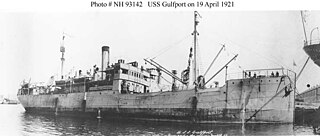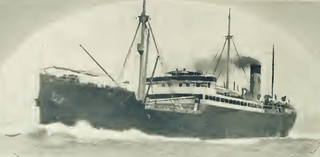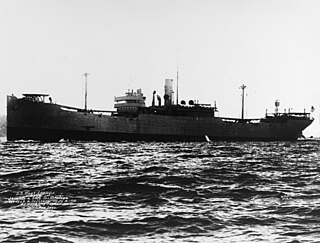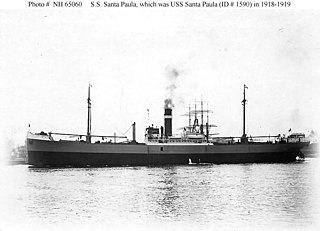Californian (ship) may refer to the following ships:
The New York Shipbuilding Corporation was an American shipbuilding company that operated from 1899 to 1968, ultimately completing more than 500 vessels for the U.S. Navy, the United States Merchant Marine, the United States Coast Guard, and other maritime concerns. At its peak during World War II, NYSB was the largest and most productive shipyard in the world. Its best-known vessels include the destroyer USS Reuben James (DD-245), the cruiser USS Indianapolis (CA-35), the aircraft carrier USS Kitty Hawk (CV-63), the nuclear-powered cargo ship NS Savannah, and a quartet of cargo-passenger liners nicknamed the 4 Aces.

USS Gulfport (AK-5) was a cargo ship acquired by the U.S. Navy for service in World War I.

USS Wilhelmina (ID-2168) was a transport for the United States Navy during World War I. Built in 1909 for Matson Navigation Company as SS Wilhelmina, she sailed from the West Coast of the United States to Hawaii until 1917. After her war service, she was returned to Matson and resumed Pacific Ocean service. In the late 1930s she was laid up in San Francisco, California, until sold to a British shipping company in 1940. While a part of a convoy sailing from Halifax, Nova Scotia, to Liverpool, she was sunk by U-94 on 2 December 1940.

USS Margaret (ID-2510) – shortly thereafter known as USS Chatham (ID-2510) -- was a cargo ship acquired by the U.S. Navy during World War I. She was used to carry cargo to Allied troops in Europe until the war's end when she was returned to the U.S. Shipping Board for disposition.

SS Montanan was a cargo ship built in 1912 for the American-Hawaiian Steamship Company. During World War I service for the United States Army Transport Service, she was known as USAT Montanan. Montanan was built by the Maryland Steel Company as one of eight sister ships for the American-Hawaiian Steamship Company, and was employed in inter-coastal service via the Isthmus of Tehuantepec and the Panama Canal after it opened.
SS Ohioan may refer to one of two ships owned by the American-Hawaiian Steamship Company

USS West Lianga (ID-2758) was a cargo ship for the United States Navy during World War I. She was later known as SS Helen Whittier and SS Kalani in civilian service under American registry, as SS Empire Cheetah under British registry, and as SS Hobbema under Dutch registry.
USS West Gambo (ID-3220) was a steel-hulled, single-screw cargo ship that served in the United States Navy from 1918 to 1919. She later saw commercial service as SS West Gambo and SS Empire Hartebeeste, and under the latter name was sunk during World War II.
SS American may refer to:
SS Honolulan may refer to one of three cargo ships of the American-Hawaiian Steamship Company:

SS Santa Paula was a freighter of the Grace Line and later the American-Hawaiian Steamship Company. The vessel also saw military transport service during both World Wars.
The following index is provided as an overview of and topical guide to Wikipedia's articles on recreational dive sites. The level of coverage may vary:

Recreational dive sites are specific places that recreational scuba divers go to enjoy the underwater environment or for training purposes. They include technical diving sites beyond the range generally accepted for recreational diving. In this context all diving done for recreational purposes is included. Professional diving tends to be done where the job is, and with the exception of diver training and leading groups of recreational divers, does not generally occur at specific sites chosen for their easy access, pleasant conditions or interesting features.

SS Albert Gallatin was an American Liberty ship that operated during World War II. She was named for Albert Gallatin (1761–1849), an American politician, diplomat, ethnologist, and linguist who served as the United States Secretary of the Treasury from 1801 to 1814. She was sunk by the Imperial Japanese Navy submarine I-26 in the Arabian Sea in 1944.

SS Cynthia Olson was a cargo ship originally built in Wisconsin in 1918 as the SS Coquina. Renamed in 1940, in August 1941 she was chartered by the US Army to transport supplies to Hawaii. While in passage between Tacoma, Washington and Honolulu on December 7, she was intercepted by the Japanese submarine I-26, which sank her with gunfire. Although the commander of the submarine ensured that all of the crew had escaped into boats, none of them were ever found. Cynthia Olson was the first United States Merchant Marine vessel to be sunk after the entry of the United States into World War II.
Tennessee is a ship name.

A. H. Bull Steamship Company was a shipping company and passenger liner service founded in New York City in 1902 by Archibald H. Bull (1848-1920). Service started with shipping between New York and Florida. His fleet of ships then added service to other Eastcoast ports. The company is also often called the Bull Lines and the Bull Steamship Line or A. H. Bull & Company. While founded in New York, Bull soon move its headquarter to Peir 5 in Baltimore, Maryland. Bull Lines main Eastcoast ports were: Baltimore, Charleston, Philadelphia, Tampa and Norfolk, Virginia. Oversea ports: Porto Rico, Antwerp, Bordeaux, Hamburg, Bremen, Copenhagen, and West Africa. Bull Steamship Line supported the US war effort for both World War I and World War II, including the loss of ships.